Sociology Essay: Evaluating the Relevance of Electoral College
VerifiedAdded on 2023/04/07
|5
|918
|452
Essay
AI Summary
This essay examines the ongoing debate about the Electoral College in America, questioning its continued necessity. It presents arguments from various scholars, highlighting the historical reasons for its establishment, such as balancing the interests of states with different population sizes. The essay also addresses criticisms regarding the lack of direct representation and the potential for disproportionate outcomes. Alternative proposals, including the Congressional District Allocation (CDA) method and proportional allocation of electoral votes, are discussed as potential reforms. The essay concludes that while constitutional amendments face challenges, states can explore aligning with the popular vote through state laws, potentially leading to the Electoral College's eventual replacement.
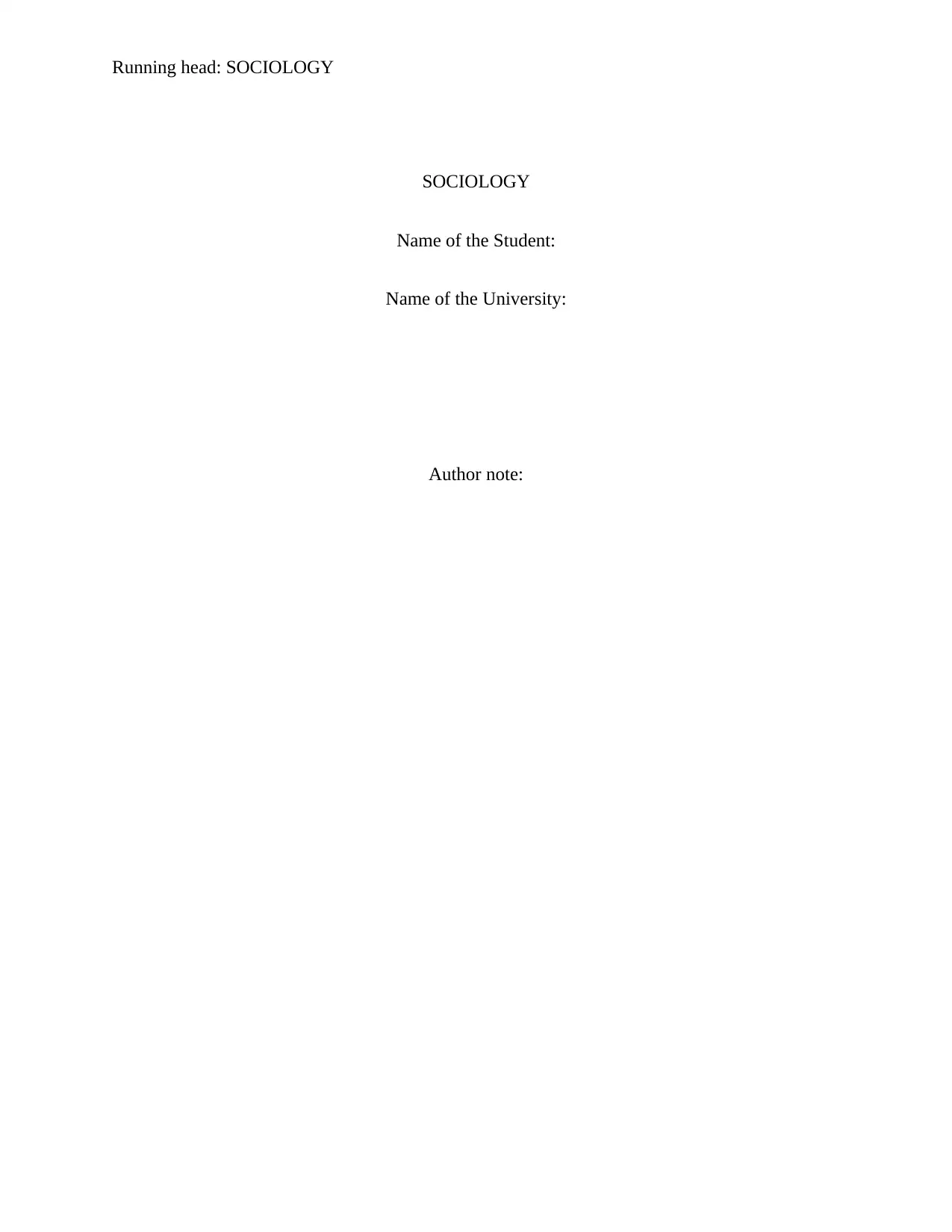
Running head: SOCIOLOGY
SOCIOLOGY
Name of the Student:
Name of the University:
Author note:
SOCIOLOGY
Name of the Student:
Name of the University:
Author note:
Paraphrase This Document
Need a fresh take? Get an instant paraphrase of this document with our AI Paraphraser
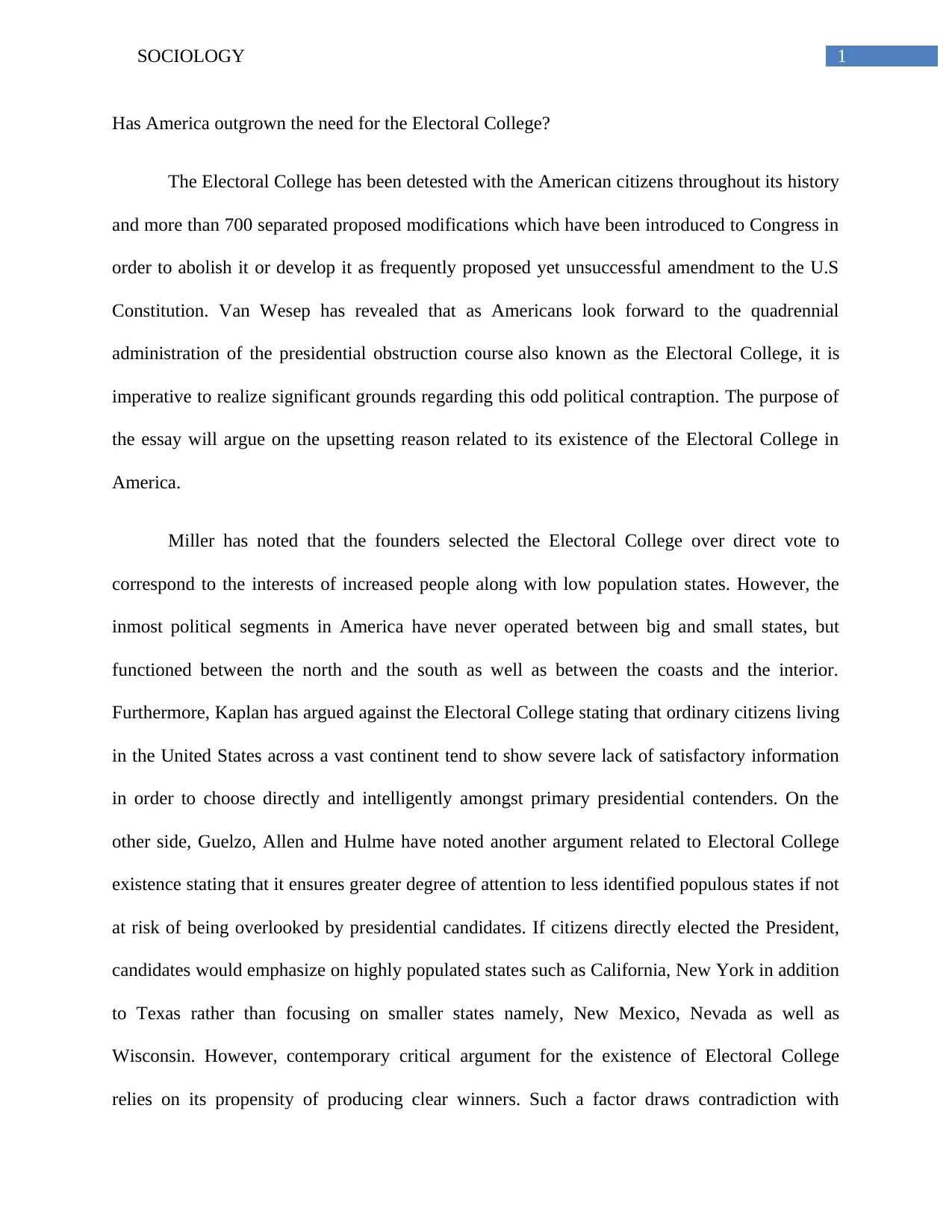
1SOCIOLOGY
Has America outgrown the need for the Electoral College?
The Electoral College has been detested with the American citizens throughout its history
and more than 700 separated proposed modifications which have been introduced to Congress in
order to abolish it or develop it as frequently proposed yet unsuccessful amendment to the U.S
Constitution. Van Wesep has revealed that as Americans look forward to the quadrennial
administration of the presidential obstruction course also known as the Electoral College, it is
imperative to realize significant grounds regarding this odd political contraption. The purpose of
the essay will argue on the upsetting reason related to its existence of the Electoral College in
America.
Miller has noted that the founders selected the Electoral College over direct vote to
correspond to the interests of increased people along with low population states. However, the
inmost political segments in America have never operated between big and small states, but
functioned between the north and the south as well as between the coasts and the interior.
Furthermore, Kaplan has argued against the Electoral College stating that ordinary citizens living
in the United States across a vast continent tend to show severe lack of satisfactory information
in order to choose directly and intelligently amongst primary presidential contenders. On the
other side, Guelzo, Allen and Hulme have noted another argument related to Electoral College
existence stating that it ensures greater degree of attention to less identified populous states if not
at risk of being overlooked by presidential candidates. If citizens directly elected the President,
candidates would emphasize on highly populated states such as California, New York in addition
to Texas rather than focusing on smaller states namely, New Mexico, Nevada as well as
Wisconsin. However, contemporary critical argument for the existence of Electoral College
relies on its propensity of producing clear winners. Such a factor draws contradiction with
Has America outgrown the need for the Electoral College?
The Electoral College has been detested with the American citizens throughout its history
and more than 700 separated proposed modifications which have been introduced to Congress in
order to abolish it or develop it as frequently proposed yet unsuccessful amendment to the U.S
Constitution. Van Wesep has revealed that as Americans look forward to the quadrennial
administration of the presidential obstruction course also known as the Electoral College, it is
imperative to realize significant grounds regarding this odd political contraption. The purpose of
the essay will argue on the upsetting reason related to its existence of the Electoral College in
America.
Miller has noted that the founders selected the Electoral College over direct vote to
correspond to the interests of increased people along with low population states. However, the
inmost political segments in America have never operated between big and small states, but
functioned between the north and the south as well as between the coasts and the interior.
Furthermore, Kaplan has argued against the Electoral College stating that ordinary citizens living
in the United States across a vast continent tend to show severe lack of satisfactory information
in order to choose directly and intelligently amongst primary presidential contenders. On the
other side, Guelzo, Allen and Hulme have noted another argument related to Electoral College
existence stating that it ensures greater degree of attention to less identified populous states if not
at risk of being overlooked by presidential candidates. If citizens directly elected the President,
candidates would emphasize on highly populated states such as California, New York in addition
to Texas rather than focusing on smaller states namely, New Mexico, Nevada as well as
Wisconsin. However, contemporary critical argument for the existence of Electoral College
relies on its propensity of producing clear winners. Such a factor draws contradiction with
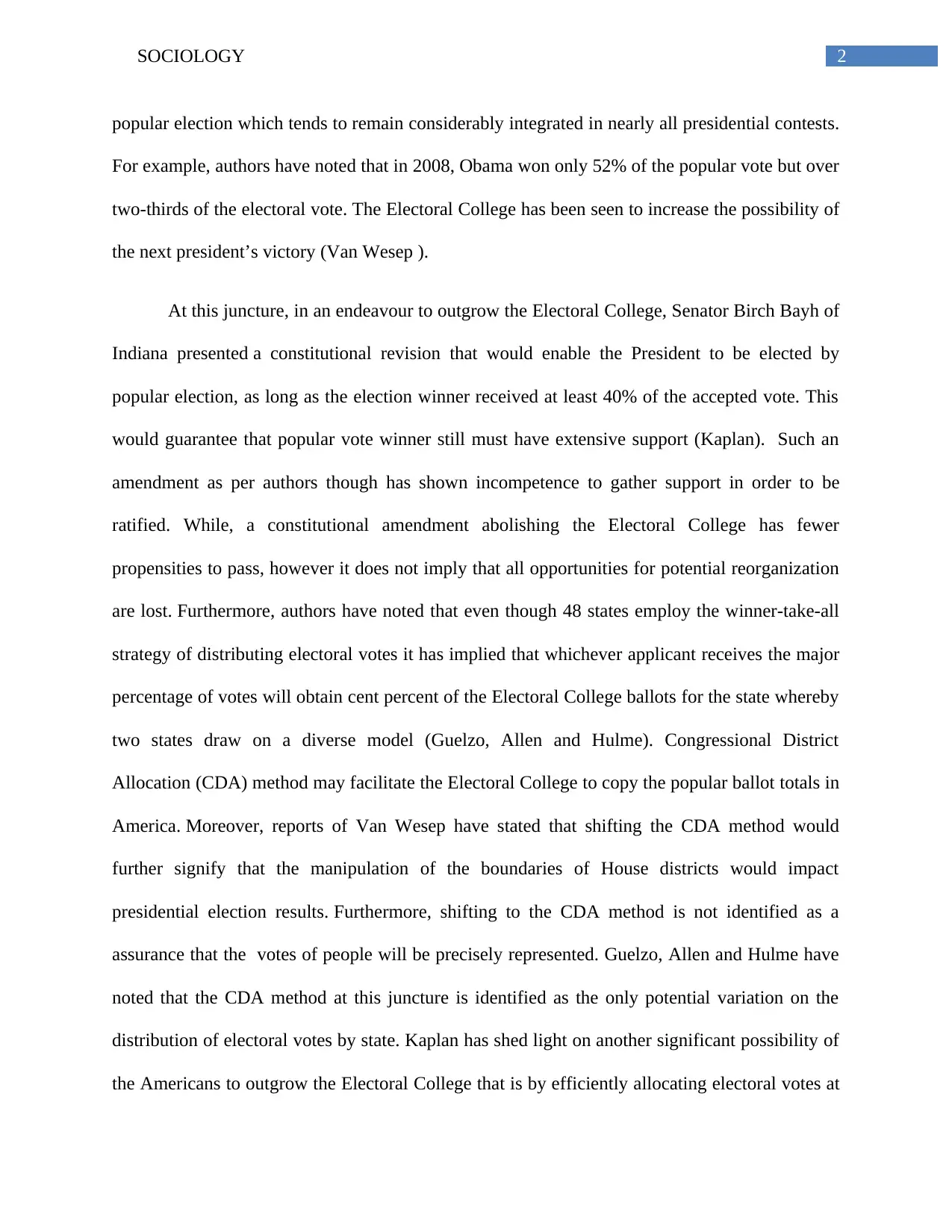
2SOCIOLOGY
popular election which tends to remain considerably integrated in nearly all presidential contests.
For example, authors have noted that in 2008, Obama won only 52% of the popular vote but over
two-thirds of the electoral vote. The Electoral College has been seen to increase the possibility of
the next president’s victory (Van Wesep ).
At this juncture, in an endeavour to outgrow the Electoral College, Senator Birch Bayh of
Indiana presented a constitutional revision that would enable the President to be elected by
popular election, as long as the election winner received at least 40% of the accepted vote. This
would guarantee that popular vote winner still must have extensive support (Kaplan). Such an
amendment as per authors though has shown incompetence to gather support in order to be
ratified. While, a constitutional amendment abolishing the Electoral College has fewer
propensities to pass, however it does not imply that all opportunities for potential reorganization
are lost. Furthermore, authors have noted that even though 48 states employ the winner-take-all
strategy of distributing electoral votes it has implied that whichever applicant receives the major
percentage of votes will obtain cent percent of the Electoral College ballots for the state whereby
two states draw on a diverse model (Guelzo, Allen and Hulme). Congressional District
Allocation (CDA) method may facilitate the Electoral College to copy the popular ballot totals in
America. Moreover, reports of Van Wesep have stated that shifting the CDA method would
further signify that the manipulation of the boundaries of House districts would impact
presidential election results. Furthermore, shifting to the CDA method is not identified as a
assurance that the votes of people will be precisely represented. Guelzo, Allen and Hulme have
noted that the CDA method at this juncture is identified as the only potential variation on the
distribution of electoral votes by state. Kaplan has shed light on another significant possibility of
the Americans to outgrow the Electoral College that is by efficiently allocating electoral votes at
popular election which tends to remain considerably integrated in nearly all presidential contests.
For example, authors have noted that in 2008, Obama won only 52% of the popular vote but over
two-thirds of the electoral vote. The Electoral College has been seen to increase the possibility of
the next president’s victory (Van Wesep ).
At this juncture, in an endeavour to outgrow the Electoral College, Senator Birch Bayh of
Indiana presented a constitutional revision that would enable the President to be elected by
popular election, as long as the election winner received at least 40% of the accepted vote. This
would guarantee that popular vote winner still must have extensive support (Kaplan). Such an
amendment as per authors though has shown incompetence to gather support in order to be
ratified. While, a constitutional amendment abolishing the Electoral College has fewer
propensities to pass, however it does not imply that all opportunities for potential reorganization
are lost. Furthermore, authors have noted that even though 48 states employ the winner-take-all
strategy of distributing electoral votes it has implied that whichever applicant receives the major
percentage of votes will obtain cent percent of the Electoral College ballots for the state whereby
two states draw on a diverse model (Guelzo, Allen and Hulme). Congressional District
Allocation (CDA) method may facilitate the Electoral College to copy the popular ballot totals in
America. Moreover, reports of Van Wesep have stated that shifting the CDA method would
further signify that the manipulation of the boundaries of House districts would impact
presidential election results. Furthermore, shifting to the CDA method is not identified as a
assurance that the votes of people will be precisely represented. Guelzo, Allen and Hulme have
noted that the CDA method at this juncture is identified as the only potential variation on the
distribution of electoral votes by state. Kaplan has shed light on another significant possibility of
the Americans to outgrow the Electoral College that is by efficiently allocating electoral votes at
⊘ This is a preview!⊘
Do you want full access?
Subscribe today to unlock all pages.

Trusted by 1+ million students worldwide
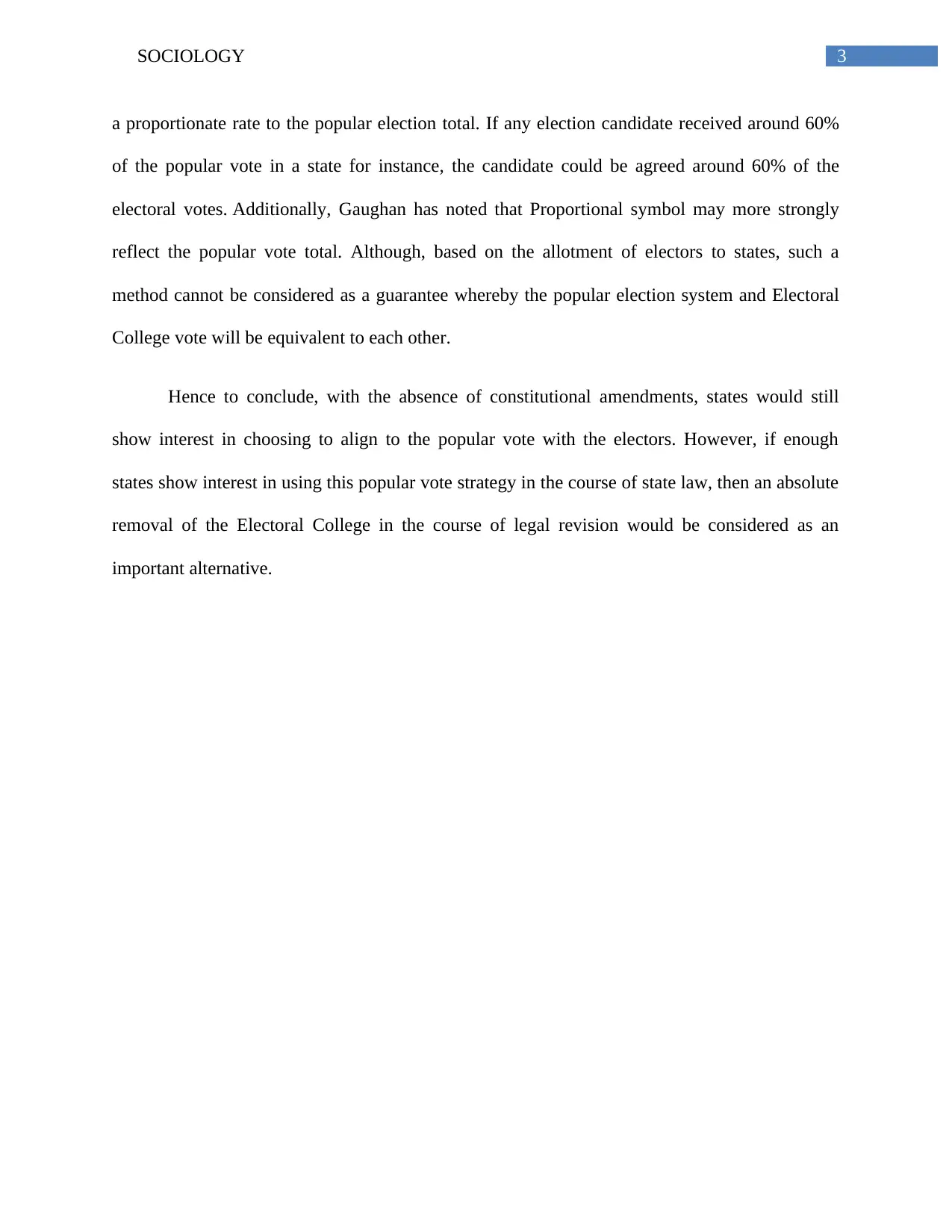
3SOCIOLOGY
a proportionate rate to the popular election total. If any election candidate received around 60%
of the popular vote in a state for instance, the candidate could be agreed around 60% of the
electoral votes. Additionally, Gaughan has noted that Proportional symbol may more strongly
reflect the popular vote total. Although, based on the allotment of electors to states, such a
method cannot be considered as a guarantee whereby the popular election system and Electoral
College vote will be equivalent to each other.
Hence to conclude, with the absence of constitutional amendments, states would still
show interest in choosing to align to the popular vote with the electors. However, if enough
states show interest in using this popular vote strategy in the course of state law, then an absolute
removal of the Electoral College in the course of legal revision would be considered as an
important alternative.
a proportionate rate to the popular election total. If any election candidate received around 60%
of the popular vote in a state for instance, the candidate could be agreed around 60% of the
electoral votes. Additionally, Gaughan has noted that Proportional symbol may more strongly
reflect the popular vote total. Although, based on the allotment of electors to states, such a
method cannot be considered as a guarantee whereby the popular election system and Electoral
College vote will be equivalent to each other.
Hence to conclude, with the absence of constitutional amendments, states would still
show interest in choosing to align to the popular vote with the electors. However, if enough
states show interest in using this popular vote strategy in the course of state law, then an absolute
removal of the Electoral College in the course of legal revision would be considered as an
important alternative.
Paraphrase This Document
Need a fresh take? Get an instant paraphrase of this document with our AI Paraphraser
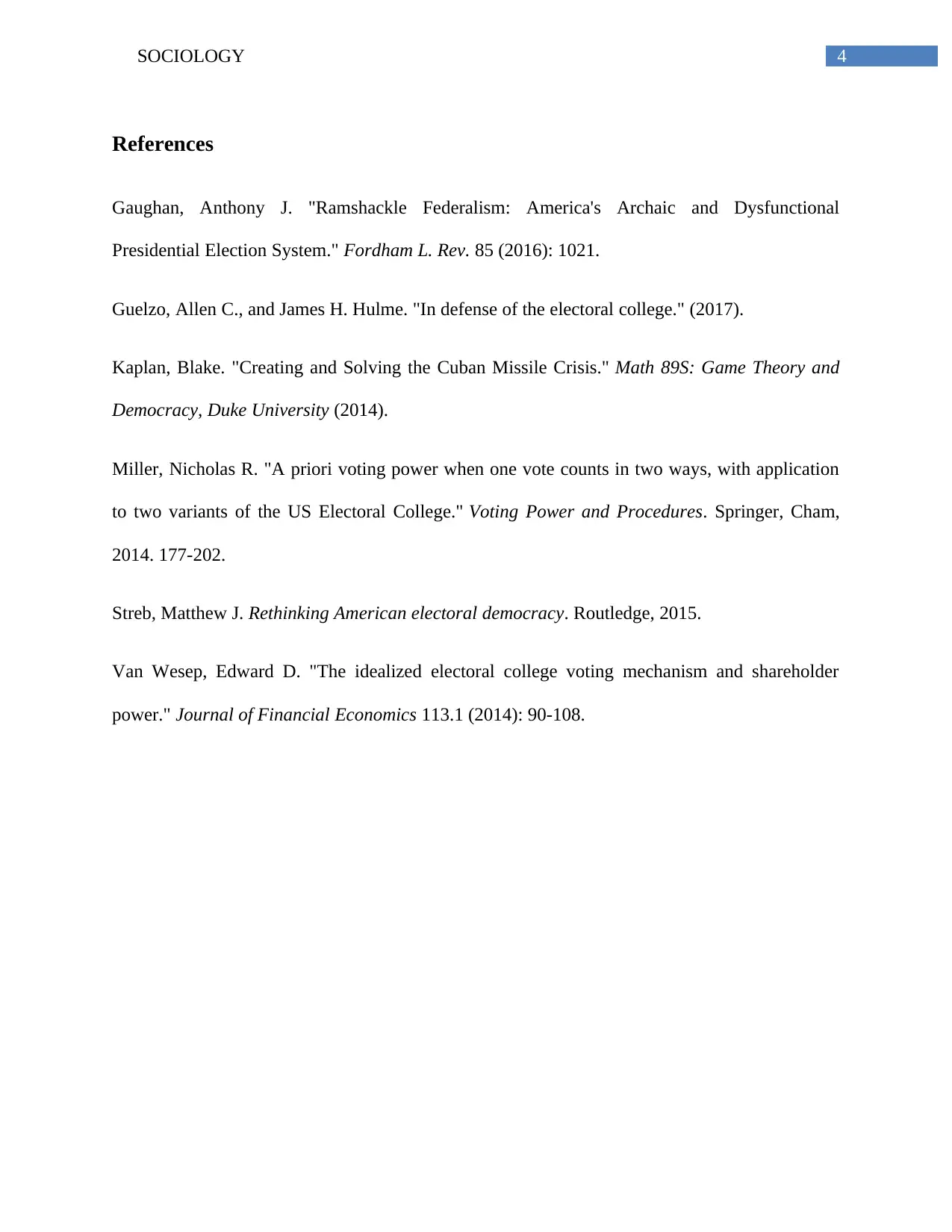
4SOCIOLOGY
References
Gaughan, Anthony J. "Ramshackle Federalism: America's Archaic and Dysfunctional
Presidential Election System." Fordham L. Rev. 85 (2016): 1021.
Guelzo, Allen C., and James H. Hulme. "In defense of the electoral college." (2017).
Kaplan, Blake. "Creating and Solving the Cuban Missile Crisis." Math 89S: Game Theory and
Democracy, Duke University (2014).
Miller, Nicholas R. "A priori voting power when one vote counts in two ways, with application
to two variants of the US Electoral College." Voting Power and Procedures. Springer, Cham,
2014. 177-202.
Streb, Matthew J. Rethinking American electoral democracy. Routledge, 2015.
Van Wesep, Edward D. "The idealized electoral college voting mechanism and shareholder
power." Journal of Financial Economics 113.1 (2014): 90-108.
References
Gaughan, Anthony J. "Ramshackle Federalism: America's Archaic and Dysfunctional
Presidential Election System." Fordham L. Rev. 85 (2016): 1021.
Guelzo, Allen C., and James H. Hulme. "In defense of the electoral college." (2017).
Kaplan, Blake. "Creating and Solving the Cuban Missile Crisis." Math 89S: Game Theory and
Democracy, Duke University (2014).
Miller, Nicholas R. "A priori voting power when one vote counts in two ways, with application
to two variants of the US Electoral College." Voting Power and Procedures. Springer, Cham,
2014. 177-202.
Streb, Matthew J. Rethinking American electoral democracy. Routledge, 2015.
Van Wesep, Edward D. "The idealized electoral college voting mechanism and shareholder
power." Journal of Financial Economics 113.1 (2014): 90-108.
1 out of 5
Related Documents
Your All-in-One AI-Powered Toolkit for Academic Success.
+13062052269
info@desklib.com
Available 24*7 on WhatsApp / Email
![[object Object]](/_next/static/media/star-bottom.7253800d.svg)
Unlock your academic potential
Copyright © 2020–2025 A2Z Services. All Rights Reserved. Developed and managed by ZUCOL.




